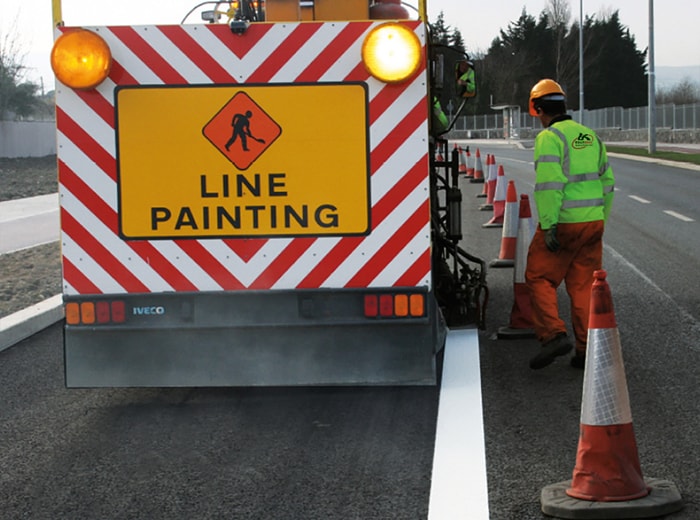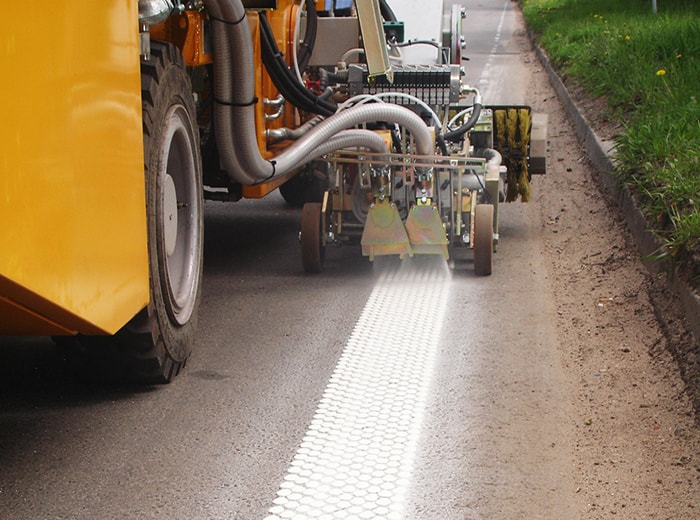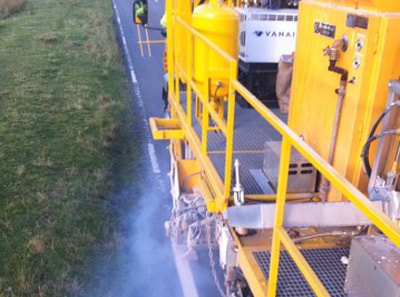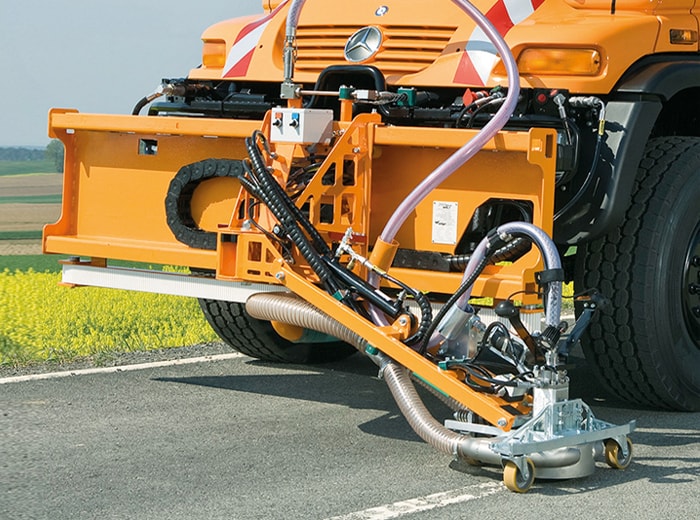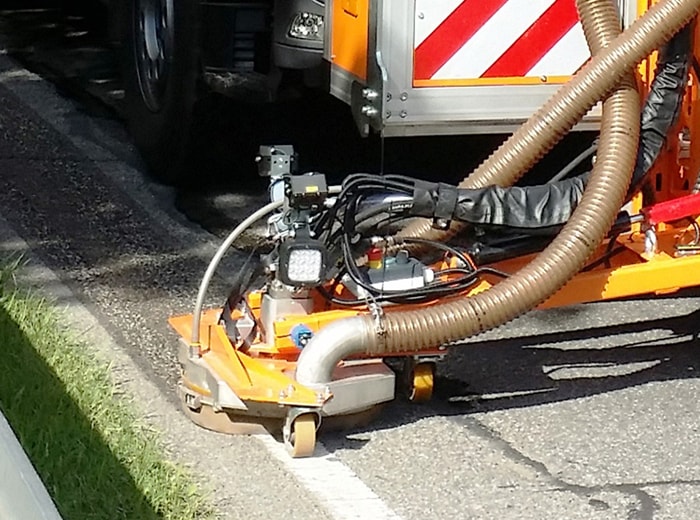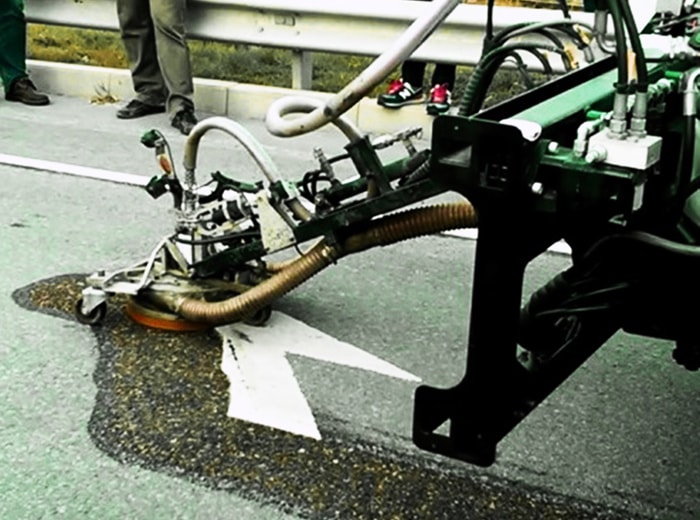EXTRUSION
Since being successfully introduced to Ireland by Kelly Bros in 1986, the extrusion application method has proven to be immensely popular. Its use has been a significant contributing factor in the improved quality and delineation of roads across Ireland and the UK. The speed of application is normally 5–8km/h and, due to this speed, it is the chosen method of road marking application for large output.
Our plant and equipment is continuously updated and modernised. For our Irish market we have designed and built a duel extruder that can carry out white and yellow markings simultaneously. This increased capacity provides an economic advantage as well as reducing carbon emissions.
Our extrusion equipment can also be adapted to carry out rib line and Drop-a-dot line to increase wet night visibility.
Process
Using an extrusion mould, the molten road marking products and glass beads are simultaneously applied to the surface by use of a mechanically propelled vehicle. The dispensing mould rides directly over the road surface and a continuous line is formed with a control gate set to a pre-determined thickness.
Recommended thickness: 2.0–4.25mm.
Output per day: 1,500–2,250m².
Usage
Extrusion is most commonly used for new surfaces and surface dressing. It is also used for the recovery of existing lines and it is therefore incumbent of the application team to ensure that the surface is adequately prepared (old lines scabbled if necessary and absolutely clean and free of dust).
SPRAY
With our custom-built spray application machine we offer an ideally suited system for overlaying partially worn extrusion lines. This method provides a low-cost alternative to extrusion where an improvement is required in terms of the performance characteristics of a line, without an excessive increase in the thickness of the line.
Process
This process employs a mechanically propelled vehicle. Spray road marking products are applied to the road by air spray under pressure through one or more oil jacketed spray plastic guns. The marking is completed by a pressurised surface application of solid glass beads and the road marking product spray pattern results in a uniformly thick, well-defined and securely-bonded line. The main benefits are speed of application (8–12km/h) and thin coat application.
Recommended thickness: 1.0–2.5mm.
Output per day: 3,750–4,500m².
Usage
Typically lines using the spray system method of application are 100–250mm in width and 1–2.5mm in thickness. This is particularly suitable for temporary lines or the renewal of old, existing lines. Spray road markings cannot offer the same durability as screed and extrusion, however, for authorities or agencies on a low-cost budget this can be a cost-effective system of application for road safety requirements.
SCREED
At Kelly Bros we fabricate our own moulds and utensils for our own assurance that our teams have access to the best tools available to carry out the work accurately and efficiently and that they are trained in their use.
The screed application system is the original method of application of road marking product material and is used for the application of letters, numerals, symbols, transverse lines and transverse yellow bar markings.
Process
The hand mould is basically a four-sided box with a handle and a slight gap in the laying wall of approximately 2.0–4.25mm to allow the road marking product through to the road surface when application commences. The following sequence can be used as a reference guide for employees whilst carrying out handworks.
- One person to pour the molten road marking product from the bucket to the mould.
- A second person directs the mould in the shape marked out on the road surface.
- At the end of the marking the operator will drag the hand mould onto a flat tray to terminate the marking.
- Immediately after application an even distribution of glass beads is to be applied using the specialised bead dispenser, if the line is specified to be reflective.
- When markings are complete the mould heating apparatus should be extinguished and all implements tidied and carefully stored on the vehicle for use at the next location.
The screed barrow is used for longitudinal and other markings where the use of an extrusion vehicle would be inappropriate. Particular attention in adjustment of the shoe is required prior to work commencing to ensure that the specified thickness and width is attained.
Usage
A low-output marking for traffic delineation, advisory markings and mandatory markings in urban areas where space is limited and for small sites where it is impractical to use truck mounted application equipment.
Screed is a hand-applied method of road marking. It is primarily used for hatching, pedestrian crossings, speed bumps, arrows and lettering. Screed is also used to complete car parks and any markings which are not capable of being applied by machine.
Recommended thickness: 2.0–4.25mm.
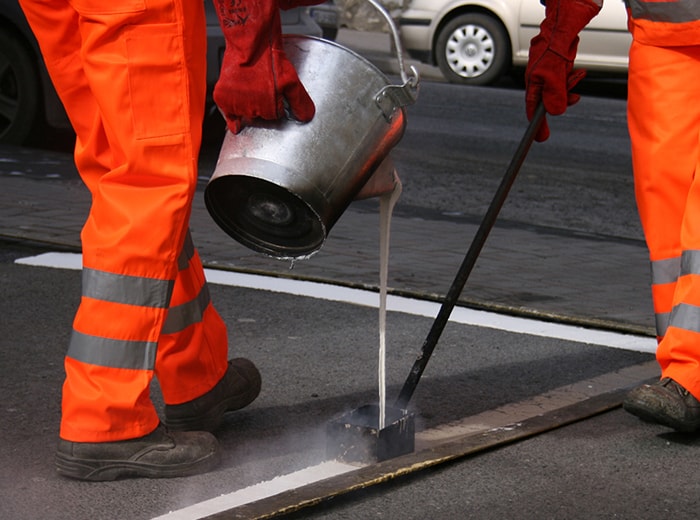
REMOVAL
Kelly Bros offer scabbling and captive water blasting removal methods. In lieu of traditional road marking removal methods, water blasting is safer for road crews, cleaner and more sustainable.
Process
Our water blasting equipment sends water jets of 40,000 psi into the pores of the road surface, effectively pulverising the marking whilst producing a minimum amount of asphalt fines. The result is an extremely precise and fast removal, with minimum damage to the surface. The simultaneous vacuum recovery system removes debris as it is created, resulting in a clean, safe and environmentally friendly removal. Scabbling removes remnants of screeding and heavy coatings from concrete, providing an even surface prior to shot blasting.
Usage
Water blasting is nearly unlimited in its removal applications. It can be used to remove newly laid road marking product, all types of temporary tapes (including permanent foil backed tapes) and waterborne, epoxy and rubberised paints.

